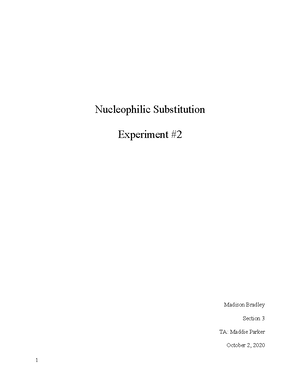

Results and Discussion Part A of the experiment aimed to convert xylan from corn cobs into furfural. To do so, 15 of corn cobs were reacted with 15 of NaCl and HCl. Heat was supplied for the reaction to proceed, and simple distillation was used to collect distillate. The aqueous phase from the distillate was discarded but the organic phase was dried using rotary evaporator to isolate 1 of crude furfural. This corresponds to a percent yield of 8% (see appendix A). A potential error lowering the yield is inadequate time allowed for the reaction to proceed. The lab manual recommended to continue the reaction until 20mL of distillate was collected; however, due to time constraints, the reaction had to be terminated after about 12 mL of distillate was collected. This meant that unreacted xylan was left in the reaction mixture and not allowed to convert into furfural. To determine the composition of the crude product, an IR spectrum was acquired. Based on the IR spectrum, the reaction successfully converted xylan to furfural. The IR spectrum shows peaks that correspond to the aldehyde as well as the C(sp 2 )-H bonds which show the presence of furfural in the distillate (see appendix B). The IR did not show the presence of any contaminants such as water due to absence of broad peak at ~3300 cm-1. The goal of part B of the experiment was to synthesize furoin from the furfural isolated from part A. Upon completing the reaction, 0 of crude furoin was acquired. This corresponds to a percent yield of 43% (see appendix A). A potential error that may have lowered the yield is during the first vacuum filtration, the filter paper didn’t completely seal and thus some solid passed through gaps. Hence, some product was lost in the liquid that was collected in the beaker underneath. The melting point (MP) of crude furoin was measured to be 120-125ºC which is a broad range, away from the literature MP of 134-135ºC (2). This means that the crude product had a significant amount of contamination from unreacted furfural or water. The crude product was recrystallized using warm ethanol to isolate 0 of pure furoin. This corresponded to a percent yield of 37% (see appendix A). A potential source of error is that too much warm ethanol was added during recrystallization, thus dissolving some of the product which could not be filtered out during vacuum filtration of the crystals. The melting point of this pure product was measured to be 133-135ºC. This is a narrower range than the crude product and is also the same as the literature MP of 134-135ºC (2). This shows that pure furoin had insignificant impurities and the recrystallization process was successful in purifying the crude product. An IR was acquired for the pure furoin to verify the purity and composition of the product. The IR contains peaks corresponding to alcohol, ketone and Csp2-H groups which are all a part of the furoin (see appendix B). The IR did not have any aldehyde peaks at around 2800 cm- 1 and 1660 cm-1 meaning that the pure recrystallized furoin did not have any traces of unreacted furfural. A 1 H-NMR spectrum for the furoin was also acquired and the peaks correspond to all eight unique protons on furoin (see appendix B). This confirms that the furoin was successfully synthesized and isolated during the experiment.
Recrystallized Furoin NMR Spectrum: Appendix C: